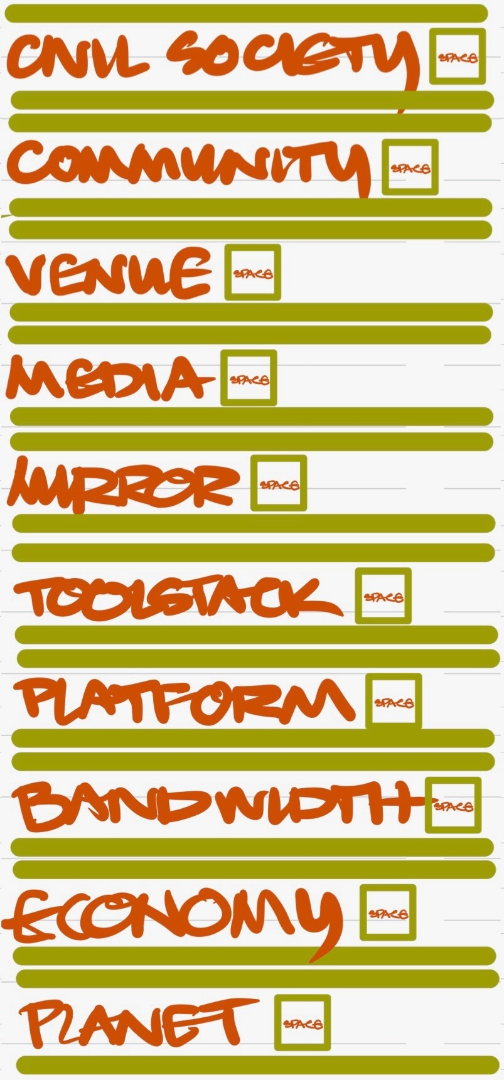All the layers of the full stack are co-present with one another, and all need to be inhabited by any robust inititative in contra-infrastructuring. What the 'full stack' model maps is in fact an ecosystem.
See: A real full stack

A real full stack
It would make sense for the Bandwidth layer, for example, to be combined with the Mirrors layer, in a single development project for a digitally mediated commons.
While the cabling (eg community cable), broadband masts and material infrastructure in a geographical region (servers, switches, data centres, etc: Bandwidth layer) is one aspect of construction and planning, it would make sense also to consider the 'architecture' of data aggregating, pooling, handling and profiling, so that users of the network were able to gain novel awareness of what in fact is occuring within their (intentionally, transparently) shared digital data space (Mirrors layer). Bandwidth layer Mirrors layer
Another example of ecosystemic interlacing across layers: if the focal community in the Community layer were an ethnic diaspora (Arabic speakers across Europe for example) then it makes sense for an infrstructuring initiative to embrace both the Bandwidth layer (the connectivity across the community) and the Media layer (the languages that media and interfaces are composed in). Etc. Media layer Community layer
We can readily generate project cases that interweave any two or more layers of the stack. The discipline of the stack model, then, is to demand that appropriate skills and relationships are mobilised, which - collectively - have adequate literacy across all the layers.
*The Economy layer* It goes without saying that any layer has 'an economy': a material constellation of practices that maintain, provision and mobilise the focal means in that layer. Economy layer
Some of the practices will be mediated by money, trade and finance. Others will be 'gift' or 'love' practices, within an overall economy of contributions. Contribution economy
Anyway, the Economy layer has to be invoked when thinking practically about any of the other layers of the full stack. The Planet layer for example is profoundly 'economic': it comprises all the basic means of subsistence for all species. At 'the other extreme' the Civil Society layer is 'economic' in being strongly configured by privilege, deprivation and denail of access, often thro financial means. Planet layer Civil society layer
# Ecosystemic mapping The ecosystemic quality of our 'real full stack' differs from the archetypal tech stacks, which are composed of distinct protocol layers. The purpose of protocol stacks is to enable independent specialist design and configuration within each layer, under a protocol for interoperability. But in our real full stack all the layers are materially co-present and 'inter-operating' with one another and, as elements of social practice, can only be analytically, and not practically, separated.
This cross-layer interlacing gives the full stack the character, in fact, of an ecosystem mapping; and 'the full stack' model is in fact only one mapping of an actual ecosystemic reality. Ecosystems are so wonderfully interleaved that theyir relationships can be mapped in endless ways. But all maps serve purposes, and 'the real full stack' is a mapping that serves the purposes of an initiative in democratic digital infrastructure(ing).